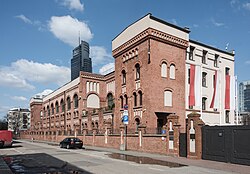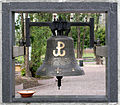
The Warsaw Uprising, shortly after the war also known as the August Uprising, was a major World War II operation by the Polish underground resistance to liberate Warsaw from German occupation. It occurred in the summer of 1944, and it was led by the Polish resistance Home Army. The uprising was timed to coincide with the retreat of the German forces from Poland ahead of the Soviet advance. While approaching the eastern suburbs of the city, the Red Army halted combat operations, enabling the Germans to regroup and defeat the Polish resistance and to destroy the city in retaliation. The Uprising was fought for 63 days with little outside support. It was the single largest military effort taken by any European resistance movement during World War II.
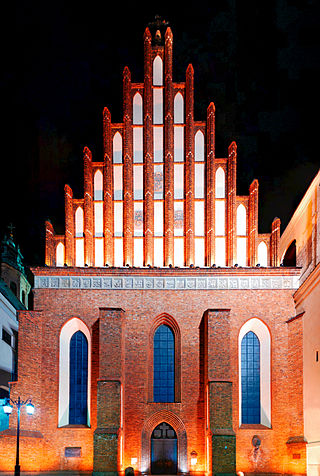
St John's Archcathedral is a Catholic church within the Old Town precinct in Warsaw, Poland. The Brick Gothic structure stands on Świętojańska Street, adjacent to the Jesuit Church. St John's is one of three major cathedrals in the city, but it is the only temple that also possesses the title of an archcathedral. It is the mother church of the Archdiocese of Warsaw and one of Poland's national pantheons. Along with the old city, the church has been listed by UNESCO as a World Heritage Site.

The Cross of the Warsaw Uprising was an informal award used by soldiers of the Polish resistance during the Warsaw Uprising of 1944. It consisted of a captured German Iron Cross, with a pre-war 1 złoty coin pinned to it in the centre over the swastika; the reverse side of the coin, showing the Polish eagle, was displayed, to which was added a kotwica and the inscription "1944". It was awarded for killing an SS officer in combat and made during quieter periods in between the fighting.
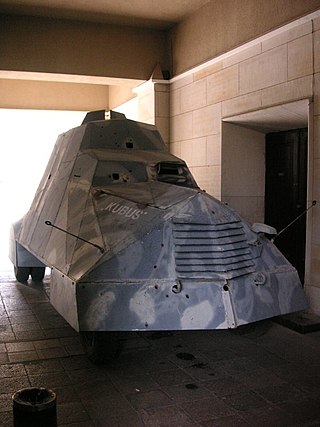
Kubuś is a Polish improvised fighting vehicle used by the Home Army in the Warsaw Uprising during World War II. The single vehicle was built in secret to function as an armoured car and armoured personnel carrier for assaults by the Home Army, where it suffered damage and was abandoned after two weeks of service. The original Kubuś vehicle survived the war and is on display in the Polish Army Museum, while a full-scale replica was built for the Warsaw Uprising Museum and frequently takes part in various open-air festivals and reenactment shows.

Rainer Joseph Karl August Stahel was a German military officer and war criminal. He is best known for his retreat from Vilna and the command of the garrison of Warsaw during the Warsaw Uprising of 1944. Arrested by the NKVD in Romania, he spent the rest of his life in Soviet captivity.

Wacław Micuta was a Polish economist, World War II veteran, and United Nations functionary.

Anna Zakrzewska served with the Polish underground army as a courier and a medical orderly. She was killed in the course of desperate combat during the Warsaw Uprising.

Edward Kossoy was a Polish lawyer, publicist and an activist for victims of Nazism.

Wacław Zagórski (1909–1982), nom-de-guerre "Lech Grzybowski", was a Polish lawyer, soldier, and socialist politician. At the end of 1939, he became the head of the underground Socialist-Independentist Organisation "Freedom" in Vilnius. He was a participant in the Warsaw Uprising with the rank of captain and a commander in the famous Chrobry II Battalion. He was decorated with the Order of Virtuti Militari 5th Class in 1944.
Leon Nowakowski, nom de guerre "Lig", was a Polish soldier, a member of the Home Army and the moderate faction of the National Armed Forces which merged with it, with a rank of major, creator and later the commander of the Chrobry II Battalion, participant in the Warsaw Uprising.
Wacław Gluth-Nowowiejski (Wacek) is a former soldier of the Polish Home Army (AK), a participant in the Warsaw Uprising, and after the war, a publicist and author. He was born in Warsaw.

Stefan Bałuk was a Polish general and photographer.
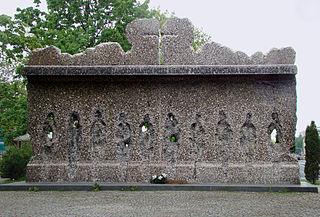
The Monument to Victims of the Wola Massacre is a monument commemorating the Wola massacre, the brutal mass-murder of the civilian population of Warsaw's Wola district, carried out by the Germans in the early days of the Warsaw Uprising, from 5 to 12 August 1944. It is located in a small square at the intersection of Solidarity Avenue and Leszno Street in Warsaw.
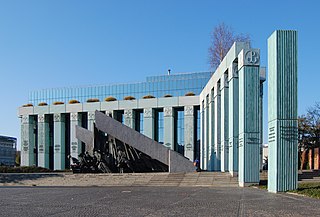
Warsaw Uprising Monument is a monument in Warsaw, Poland, dedicated to the Warsaw Uprising of 1944. Unveiled in 1989, it was designed by Jacek Budyn and sculpted by Wincenty Kućma. It is located on the southern side of Krasiński Square.

The execution at Powązkowska Street - a mass murder of 22 Warsaw residents of Powązki by the Germans on 1 August 1944. This execution, which claimed the lives of men living in a house at 41 Powązkowska Street, was one of the first German crimes committed during the suppression of the Warsaw Uprising.

Stauferkaserne prison was a provisional prison, and at the same time a gathering point for expelled Warsaw residents, established by the Germans during the first days of the Warsaw Uprising on the grounds of the SS-Stauferkaserne barracks at 4 Rakowiecka Street. In August and September 1944 over a thousand residents of the district passed through the SS barracks in Mokotów. They were detained there in harsh conditions and were subjected to extremely brutal treatment. During the Warsaw Uprising, the Stauferkaserne area was the scene of numerous executions, the victims of which were at least 100 people.

The Suppression of Mokotów was a wave of mass murders, looting, arson and rapes that swept through the Warsaw district of Mokotów during the Warsaw Uprising in 1944. Crimes against prisoners of war and civilians of the district were committed by the Germans until the capitulation of Mokotów on September 27, 1944, although they intensified in the first days of the uprising.
Józef Kempa was a Polish actor. He was active in theatre and film between 1918 and 1944. He was a civilian fatality of the Warsaw Uprising, dying in the explosion of a German Borgward IV demolition vehicle on 13 August 1944.

Róża Maria Goździewska was a Polish nurse, known as the youngest nurse of the 1944 Warsaw Uprising when she was a child.

Wanda Traczyk-Stawska ps. "Pączek", „Atma” is a Polish psychologist and social activist. She was involved in the Polish underground resistance movement during World War II, a soldier of the Home Army, a member of the Gray Ranks, a participant in the Warsaw Uprising, and chairperson of the Social Committee for the Cemetery of Warsaw Insurgents.
